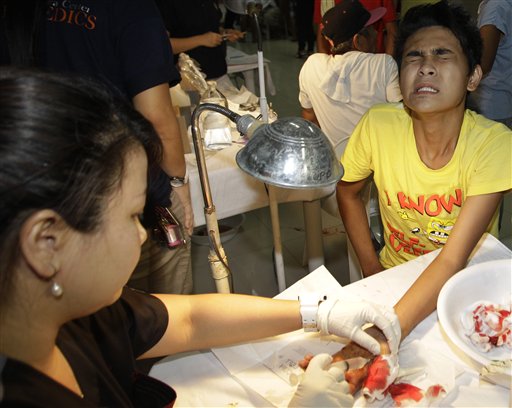MANILA, Philippines — Despite the authorities’ appeal to the public to use other methods of noise-making for the holidays, the number of firecracker users has increased this year, according to the Department of Health. So have the injuries.
Assistant Health Secretary and National Epidemiology Center director Dr. Eric Tayag said in his Twitter account that the number of firecracker users was up by eight percent this year compared to 2012.
According to the “Aksyon: Paputok Injury Reduction 2013” report of the DOH-NEC, which started recording injuries last Dec. 21, 115 or 70 percent of fireworks injuries reported involved active users of firecrackers.
The DOH noted that fireworks-related injuries continue to increase in the days leading the New Year as it recorded a total of 170 fireworks-related injuries as of 6 a.m. Saturday, most of which were caused by a banned firecracker called “piccolo.”
The figure was two-percent higher than the 167 injuries recorded during the same period last year.
Sixty-two percent or 101 cases of fireworks-related injuries were caused by piccolo, Tayag said.
Tayag urged the Philippine National Police to intensify its crackdown on piccolo and other illegal firecrackers, saying the DOH has received reports that the items were being sold openly near a police station in Pasay City.
The DOH report also said that out of the 170 fireworks-related injuries, 78 cases or 46 percent occurred in Metro Manila, followed by 17 cases in Northern Mindanao.
There was one case of firecracker ingestion and five cases of stray bullet injury.
Most of the injured were males, 49 of whom were children under 10. Forty-nine were passive users or bystanders.
A total of 147 persons sustained blast injuries not requiring amputation and there were 16 eye injuries. Two victims had blast injuries that needed amputation, the DOH said.
Meanwhile, the DOH released on Saturday a list of “most dangerous” villages in terms of firework-related injuries based on 2010-2012 reports.
Barangays in Quezon City with a high number of reported cases during the last three years included Batasan Hills, Commonwealth, Holy Spirit, Payatas, Sto. Domingo and Krus na Ligas.
In Manila, the villages with a high number of reported cases included District 2, particularly Barangay147-267 East Tondo; District 1 Barangay 1-146 West Tondo; District 3 Barangay 268-394; Binondo, Quiapo, San Nicolas and Sta. Cruz.
In Mandaluyong, the villages on the list were Addition Hills, Hulo, Barangka Drive, Poblacion, San Jose and Plainview.
In Valenzuela, the most dangerous villages were Hen. T. de Leon, Marulas, Karuhatan, Canumay, Malinta and Parada.
In Las Piñas, the villages of Pulang Lupa Uno, BF International Village, Talon Dos, Pulang Lupa Dos and Fajardo were on the list of most dangerous places.
In Pasig, the villages on the list were Pinagbuhatan, Bagong ilog, Pineda, Bambang, San Miguel, Kapasigan, San Joaquin and Kalawaan.
In Marikina, the villages of Malanday, Concepcion Uno, Parang and Sto. Niño were considered most dangerous.
RELATED STORIES:
DOH calls for alternative noise makers as 21 hurt by firecrackers since Dec. 21
Manila police test ‘Napoles,’ ‘Yolanda’ firecrackers
22 hurt by firecrackers, 3 by stray bullets


